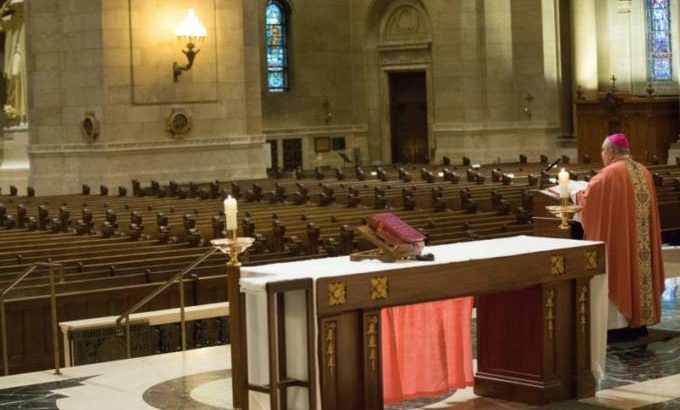Why did the bishops go even further than the Government required by telling priests aged over 70 to strictly cocoon, asks David Quinn
A delegation from the bishops’ conference held an online meeting with Taoiseach Leo Varadkar last week to discuss a return to public Masses. A statement was released by the bishops afterwards. It was remarkably uninformative.
Here it is in full: “The Taoiseach, today (Thursday, May 14), met with representatives of the Catholic Church, Archbishop Eamon Martin, Archbishop Diarmuid Martin and Archbishop Kieran O’Reilly (president, vice-president and secretary of the Irish Episcopal Conference) to share thoughts on the reopening of places of worship over the course of the summer. The Church shared information on the work that is being done at all levels to develop a national Church plan for the safe reopening and emphasised it will play its part in applying public health measures to ensure the health and safety of its congregation.”
What is most notable is what is missing from it: namely any indication of a date to return to public Masses. Officially the date set in the Republic is July 20 (there is worryingly no timeframe in the North). This is not to say we will return to normal then. Strict social distancing and proper hygiene measures will still apply. But there was no hint that the bishops are applying any pressure for an earlier return.
Distancing
The July 20 date in the south seems to be one of the latest in Europe. Public Masses, with appropriate physical distancing, began again in Italy on Monday, for example. That is a full two months earlier than here. Admittedly they went into lockdown about three weeks earlier than we did, but the outbreak in northern Italy was much more severe. How can we justify a much later return date than Italy, or France, Spain, Germany, Austria, the Netherlands, etc. for that matter?
In an interview on RTÉ last Thursday, Archbishop Diarmuid Martin [pictured above] was asked by Sarah McInerney whether he thought Masses would return by the end of the year, never mind July 20.
He responded: “I think it’s possible.” Again, no mention of seeking an earlier return.
Health and safety obviously matter, but we can assume that bishops in other European countries are not being more reckless and irresponsible than our own in pressing for, and securing, earlier return dates than here. Maybe our bishops are being too cautious?
A further example of how cautious our bishops are being is that in respect of priests over-70, they told them to cocoon, even though the Government explicitly said priests in this age group could still privately say online Masses in their churches, officiate at funerals (at which no more than ten people could gather) and continue chaplaincy services.
In other words, the Government saw that priests over-70 were carrying out essential duties. Why, then, did the bishops go even further than the Government required by telling priests in this age group to strictly cocoon?
The choice is between excessive caution, and a small, calculated risk”
A lot of people aged over 70, including clergy, are still very fit and well and have no underlying conditions. Some clergy over 70 would surely have been happy to continue with limited ministry. For one thing, it would have taken pressure off their younger colleagues.
A priest is supposed to be a shepherd to his people, willing to lay down his life for them if need be. How compatible is an excessive attachment to health and safety with this essential aspect of the priesthood? Have we lost sight of it?
In truth, a healthy 75-year-old priest would be at minimal risk celebrating a private Mass in his church. There would be only a tiny risk involved in officiating at a funeral with very limited numbers present. With the right personal protective equipment, there would also be very little risk administering the sacraments to sick patients in hospitals or care homes.
In the past, priests took far more risks in times of plague ministering to their people.
In the Black Death of the 14th Century, it is estimated that 30% of all people died, but almost half of priests because so many were willing to risk their lives, as a good shepherd is called to do.
In the aforementioned interview, the Archbishop of Dublin was asked: “Just in terms of nursing homes and obviously the very tragic situation there in the last couple of months, would you like to see priests been able to get back into nursing homes to give the Last Rites?”
Archbishop Martin replied: “I think if it’s safe for them to do that, it should be done but the important thing is nobody’s life should be put at risk, neither the priest nor [the patient]”.
But if you applied that attitude to the past, no priest would ever have put his life at risk during times of plague, or maybe for any other reason.
Is that really the spirit of Christianity? Is that really the calling of the priest; no risk at all?
The choice here is not between caution and recklessness. The choice is between excessive caution, and a small, calculated risk, such as is involved in having 40 people rather than 400 attending Mass in a church, such as in now happening in countries like Italy.
An excessive health and safety mentality is ultimately incompatible with the Gospel.


 David Quinn
David Quinn Archbishop Bernard A. Hebda of St. Paul and Minneapolis delivers his homily in an empty Cathedral of St. Paul.
Photo: CNS
Archbishop Bernard A. Hebda of St. Paul and Minneapolis delivers his homily in an empty Cathedral of St. Paul.
Photo: CNS 